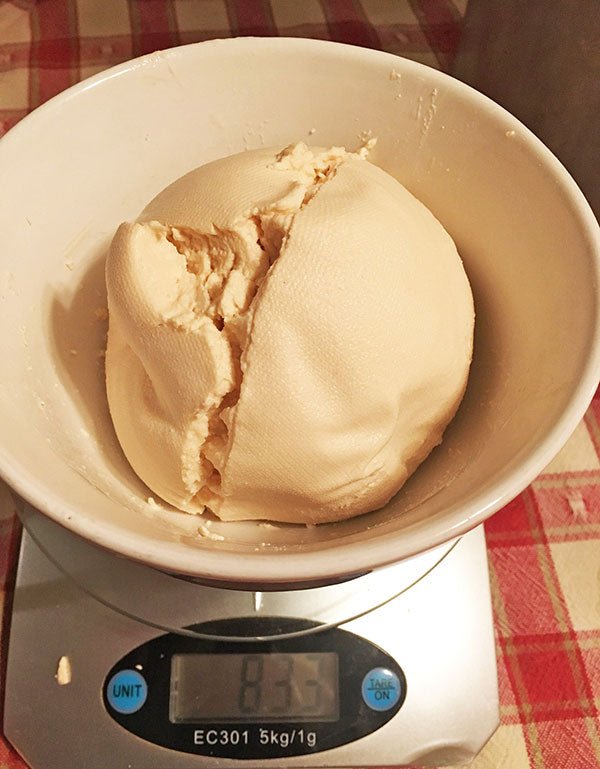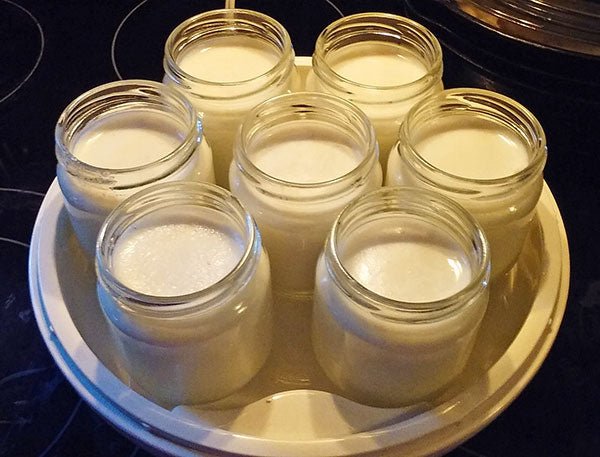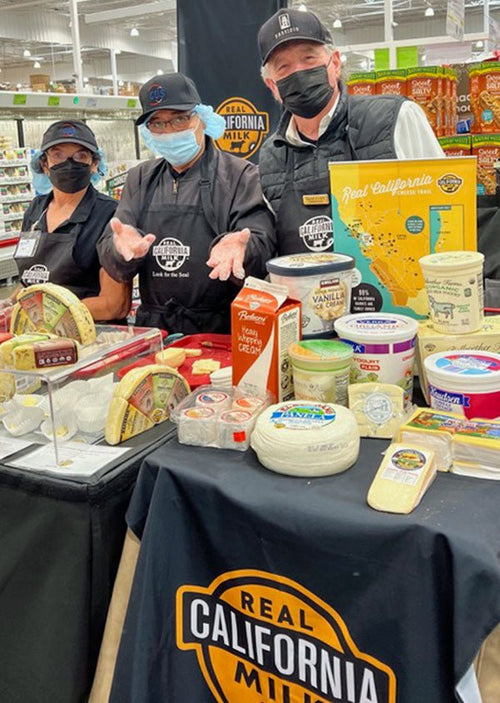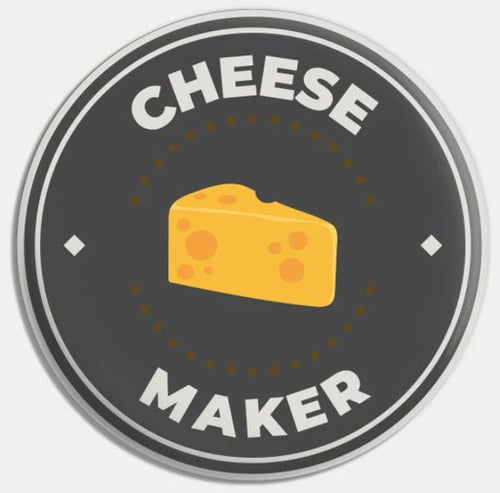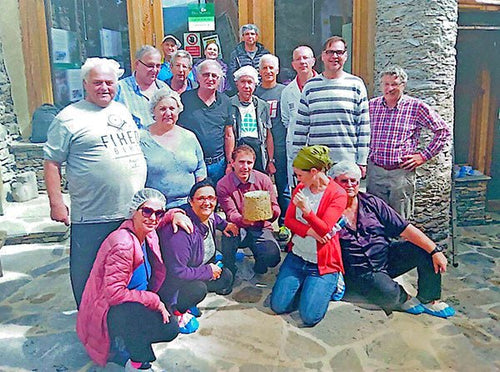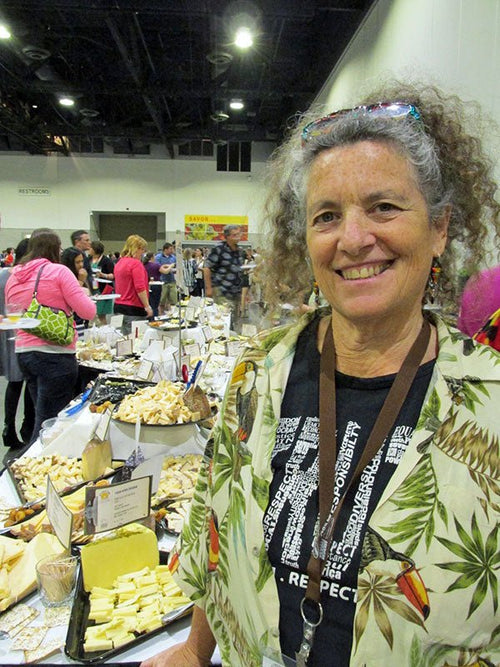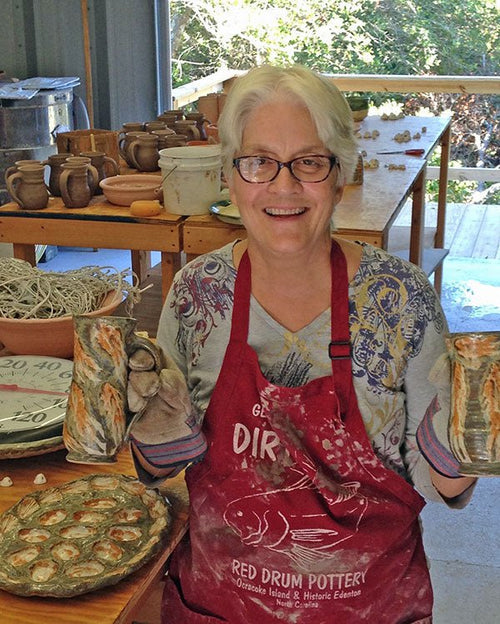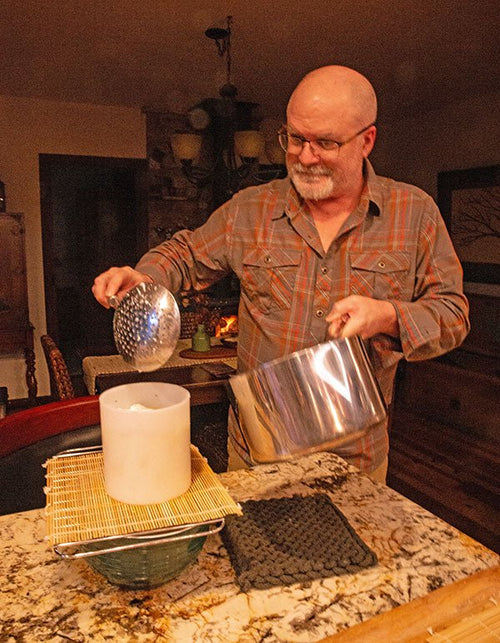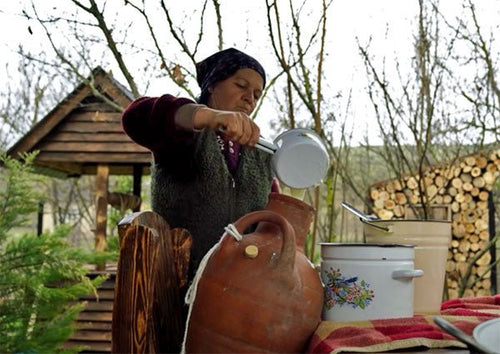Our good friend, Howard Dewsbury contributed his first article to our blog in 2016 – Howard’s Own “Small Cheese” Recipe. He is retired and living in Barrie, Ontario, Canada. Besides cheese, he also makes beer, wine and cured meats. We’re working on an article about Howard now, so, you will learn more about him soon.
Disclaimer: We have not tried Howard’s method yet, so, if you do, please let us know in the comments. We do have a similar recipe for ricotta in our extensive recipe section – click here.
Making Ricotta Cheese
By Howard Dewsbury

Our friend, Howard Dewsbury
It always seems that the amount of whey leftover from making cheese is not that much less than the amount of milk you started with. It seems a waste to throw it out but as a home cheese maker there is only so much I can use for making bread and other minor uses. I have no safe way to store it so I know most will go down the drain. I know there are other uses for it but I don’t have a garden or animals to feed it to.
However, before that happens, I always take the ricotta from the whey, use some for bread, pasta etc. Knowing I am going to throw it out means I don’t care what the final whey tastes like and I have developed a method of maximizing the amount of ricotta I recover.

Whey and vinegar before boiling
Ricotta is the process of recovering any proteins present in the whey after making cheese. The proteins are recovered by adding acid to the whey and heating it close to or at the boiling point. The amount of protein recovered depends on the amount of protein present and the amount of acid added. If you remember your chemistry, you will know that this depends on there being sufficient moles of acid to react with all the moles of protein in the whey. That being said, to most of us this is only a foggy memory from college days, but, just the same, it is the theory behind how I make ricotta.

Boiling whey
When I first started making cheese, I quickly noticed that the amount of ricotta varied each time I made it. The question was: is this because the amount of protein in the whey varies with the type of cheese that was made, with the amount of acid added or a bit of both? I concluded that it was likely both. Since I have no way of measuring the amount of protein in any given batch of whey, I could not accurately calculate the amount of acid needed to get the most ricotta.

Whey cooling
Since I don’t care what the whey tastes like once I have recovered the ricotta, the solution was easy – just add more acid than needed. Vinegar is the cheapest and most available acid, so that is what I use. Took a few tries, but soon came to a ratio of 1 part vinegar to 10 parts whey for maximum ricotta recovery.
One other thing I observed is that if you strain the whey when it is hot, the ricotta may be soft and fine and simply pass through the filter unless the filter is very fine and that can be an extremely slow process.
So, after the cheese has been made I measure the amount of whey, add the amount of vinegar required and bring the mixture to a boil. I then cover the pot and let it cool overnight.

Ricotta the bottom of the pot
The next day I pass the whey through a filter (jelly bag or grain bag for making beer), let this drip until the ricotta reaches the desired constituency, and remove the ricotta from the filter into a container for storage.

Pouring the whey into the strainer

Straining the whey

Capturing the ricotta
Occasionally the ricotta is still very fine and passes through, even when cooled, and I have to run the ricotta through a finer filter. For this, I use a cheap pillow case from the dollar store as suggested by my brother Rick.
The amount of ricotta will always vary depending on the type of cheese you have made, but this method of making ricotta gives you the maximum yield. Despite the large amount of vinegar used, the ricotta does not taste of vinegar. The leftover whey however, does. The high acid whey makes good bread and pasta however is not suitable for much else, and since I have no way of storing the whey for other uses, down the drain it goes.
Each time I make cheese, I divide the cost of the ingredients by the weight of the cheese made and the ricotta recovered and the cost of the whey leftover is negligible.
The ricotta in the accompanying photo was recovered from a batch of cream cheese and a small Cheshire cheese I made. I used 4 litres (1 gallon) of whole milk plus 473 ml (17 oz) of 35% cream and a package of NECS buttermilk culture to make the cream cheese and 8 litres (2 gallons) of whole milk to make the Cheshire cheese. This left about 10 liters (2 1/2 gallons) of whey that I added 1 liter (1 quart) of vinegar to and boiled. After filtering this the next day, I had 639 gm (22.5 oz) of ricotta.

What to Do With the Ricotta
Once you have made the ricotta, the question is “What do you make with it?” Cannoli is usually one of the first things that comes to mind and I do occasionally make them, but more often, I have better uses for it. To that end, I have included several of my recipes that use ricotta.
One warning – I don’t actually measure too much when cooking, so the amounts stated below are approximate and can be adjusted to taste. Apparently, I am a good cook despite this, but it is hard to get two meals that taste exactly the same out of me.
Ricotta Cheesecake

Most people think of cheesecake being made from cream cheese and for years I thought that. After recovering a large amount of ricotta one time and being tired of cannolis, it struck me that ricotta would make a good cheesecake so I made one. The result was a much lighter tasting and bodied dessert. Ricotta doesn’t have the same level of fat as cream cheese so I assume it is healthier, as I tell myself.
Base
3 cups graham cracker crumbs
½ cup sugar (brown or white)
¾ cup melted butter
Mix the ingredients together and press into bottom of spring pan.
Filling
3 cups ricotta
3 eggs
1 tsp vanilla
Mix ricotta, eggs and vanilla together until creamy, pour over base and bake in 375F oven until it starts to brown at the edges. Check in middle to see if toothpick comes out clean.
Let cool.
Topping
For the topping, I use whatever fruit either fresh or frozen that I have available. To make it, I place the fruit in a pan with a small amount of sugar or maple syrup and boil it until it starts to thicken, pour it over the cooled cheesecake then add some of the fresh fruit or thawed fruit on top.
In the above photo I used frozen strawberries.
Bacon Wrapped Pork Tenderloin With Ricotta and Spinach Stuffing

Ingredients:
1 package of bacon
1 medium size pork tenderloin
1 ½ cup ricotta
1 package fresh spinach
Herbs and spices as desired, sage, dill, basil what ever your choice is.
Mix herbs and ricotta together, set aside, wash spinach and set aside.
Using a sharp knife, cut tenderloin lengthwise rolling it out as you cut until you have a thin flat piece of pork. Pound to tenderize the meat. Spread the ricotta and herbs evenly on the flattened pork, top with the spinach. Roll the pork so that the spinach and ricotta are encased in the meat.
Lift one end of the meat and slide a strip of bacon at 90 degrees to the meat at the mid point, lower the meat and wrap the bacon around the pork. Continue this until half the tenderloin is wrapped, then do the other half.
Bake at 375F until done. Slice and serve.
I like to cook the potatoes and carrots or other vegetables in the same pan for added flavour.
Ricotta and Spinach Ravioli

Pasta
To make pasta, you should always use the formula of 50 gm semolina, 50 gm all purpose flour and 1 egg or 50 gm whey or water, (do not use volume it doesn’t work for pasta). If you are using flour only it is 100 gm flour to 1 egg or 50 gm water. This ratio can be easily scaled for the amount of pasta required. A batch from 200gm flour and 2 eggs is more than enough for two people.
Place the flour on a pastry sheet or in a bowl, make a hole in the center of the flour for the eggs and mix them together. The dough should be very dry for rolling in the pasta machine. You can also do this in a food processor, however, it will likely need some hand mixing to finish it. If the dough is too moist, sprinkle flour on it and mix some more.
Roll the dough into long sheets with the pasta machine until it gets to the number 6 thickness setting. If you are using a ravioli mould place one sheet on the mould, press it down, place the filling in the depressions, cover with a second sheet and roll the mould to form the raviolis. If you are using a cutter, spread one sheet out, place dollops of filling on the sheet, cover with a second sheet and cut the raviolis out.
Filling
As the name implies, there is ricotta and spinach in the filling. After that, you can add parmesan, ground meat, any herbs and spices and anything else you want. Mix all the ingredients in a food processor until you have a fairly fine mixture.
Sauce
Olive oil
Ground meat or sausage (optional)
Chopped mushrooms
Chopped onions
Chopped garlic
Chopped peppers
1 can diced tomatoes
1 bottle strained tomatoes
Chopped fresh basil
Salt and pepper
Red wine (optional)
Place olive oil in a large frying pan. Add the ground meat and saute until lightly cooked. Add the mushrooms and onions and continue cooking until they are soft. Add garlic, peppers, diced and strained tomatoes, basil, salt and pepper to taste and red wine. Let simmer while the ravioli cooks.
Bring a large pot of water to a boil, then, add a teaspoon of salt to the water. Place the ravioli in the boiling water and cook until done. Test a corner of a ravioli when you think it is done – you don’t want to over cook pasta.
When done, you can place the pasta in a large pasta bowl or on individual plates, cover with the sauce, sprinkle with parmesan and red chilies.
Ricotta Gnocchi

The ricotta I recovered from the cream cheese and Cheshire cheese was orange, so, I didn’t think it would look too good in cannolis or cheesecake and wanted something besides ravioli. Gnocchi came to mind, and you can substitute ricotta for the potatoes. Turns out I was not the first to think of this.
I knew the dough for gnocchi needed to be soft and workable by hand, so, I set out to make the dough.
The Dough
1 ¼ cups ricotta
2 eggs
½ cup grated parmesan
1 teaspoon basil
½ teaspoon garlic powder
½ teaspoon salt
1 ½ cups all purpose flour
Place the ricotta in a large mixing bowl and beat with a whisk to loosen it, add eggs and whisk together until creamy. Add parmesan, basil, garlic and salt and whisk it all together.
Add the flour and use a wooden spoon to mix the flour into the cheese mixture, mix just enough to blend the flour in, remember you want a very soft dough. Turn the dough out on to a pastry sheet and divide into sections about 1 cup in size.

The dough
Roll out each section by hand until it forms a long strand about ½” in diameter, cut the strand into pieces about 3/4″ long.
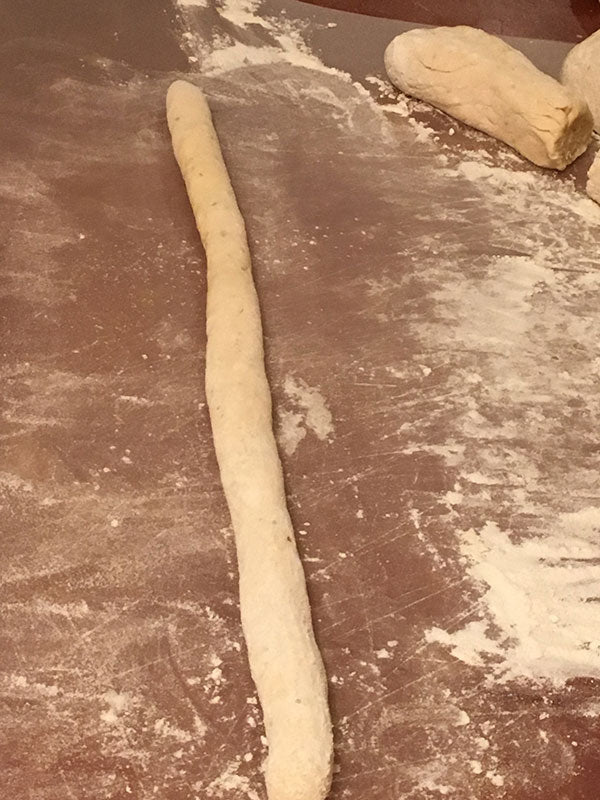
Dough rolled out
If you have a gnocchi board you can form the gnocchi on it, if not use a fork to press down on the dough then drag the fork so that the dough starts to curl over itself.

Formed gnocchi
Cook in salted boiling water until just done, do not over cook.
The sauce used for the ravioli also works with gnocchi, a butter and herb sauce is also nice.
Enjoy.




























